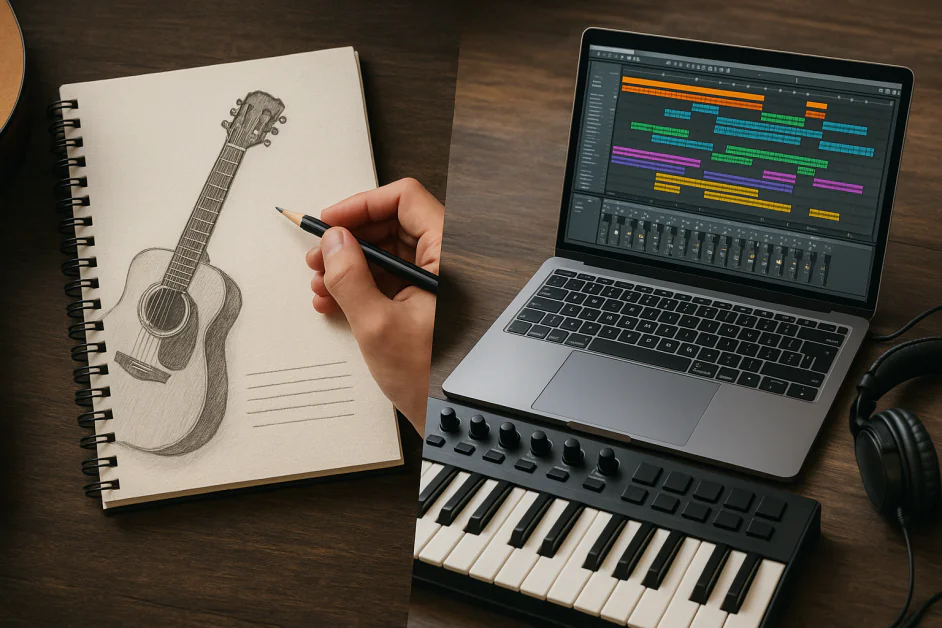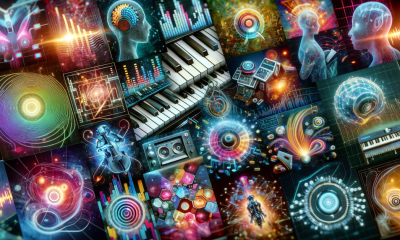Thought Leaders
From Sketch to Song: How AI Can Speed Up Your Composition and Production

Music creation has always been a delicate balance between inspiration and craft. While inspiration remains uniquely human, there is also a lot of repetitive manual work and the technical aspects of making music can prevent ideas from becoming finished compositions. Nowadays, in the AI era, music creators can delegate much of that routine to intelligent tools, providing more space for creative exploration. With that in mind, here’s how AI can support your composition, arrangement, sound design, and production processes.
1. Kickstart ideas with AI-generated musical sketches
Every composer knows the feeling: deadline looming, blank DAW staring back at you, instruments sitting silent. AI can provide a crucial creative spark to get things moving. Modern algorithms generate melodic sketches based on stylistic inputs, intended as starting points rather than final compositions.
A compelling example is composer Lucas Cantor’s completion of Schubert’s Unfinished Symphony using AI trained on the master’s own compositions. The machine offered melodic ideas that Cantor then developed and orchestrated. In commercial settings, similar tools can offer inspiration that gets refined by human creativity.
2. Auto-arrange your composition
One of the most practical applications of AI lies in auto-completing musical ideas. Picture this, you’ve stumbled upon an interesting chord progression on your guitar but the melody just won’t come. Or maybe you have a killer vocal hook stuck in your head but need harmonic support to bring it to life.
Contemporary AI tools can analyze your existing material and suggest complementary elements, whether that’s instrumental parts, rhythmic patterns, or harmonic progressions. The system takes detailed user input about playing style, reference artists, and genre specifications, making the suggestions increasingly relevant and usable.
3. Streamlining instrumentation and mixing
Making a MIDI track sound great can be daunting, especially for less experienced users. AI could help, by suggesting which instruments and plug-ins to use –creating a certain sound that can be verbally described or provided as an audio reference. Having finished the recording and instrumentation of a track, getting the mix right is not trivial. AI-based mixing assistants can help find the right mixing parameters and suggest frequency and dynamic-processors to make the result sound great. For example, in your musical project drums and bass are programmed in MIDI. Guitars and vocals are recorded by humans. After finishing the MIDI tracks and the recording, AI can find MIDI instruments and set mixing or plug-in parameters to accomplish a certain style and sound that can be refined in a chat-like interface.
4. Use AI to master your tracks
A great-sounding mix is not the final step. Mixing is done in a controlled studio environment with high-quality speakers, while music is played back in many different ways. The final track must work equally well on low-quality playback, like smartphone speakers or basic headphones, and on high-end Hi-Fi systems in well-balanced rooms.
Mastering engineers handle this by using equalization and dynamic processing to adjust the finished mix, so it sounds good in all these situations. AI-based mastering tools can now do this automatically. They control digital processing tools based on learned profiles of different speakers and listening environments, making the final sound as close as possible to the desired quality across all playback systems.
5. Generate new sounds and instrument samples based on existing material
Composers and arrangers strive to make their creations stand out by using new, previously unheard sounds. Using methods from generative AI (for example, Diffusion-based methods like Stable Audio or Dance Diffusion) enables music creators to control sound characteristics with textual descriptions and prompts instead of having to adjust huge parameter spaces implied by plug-in chains in DAW’s. Instead of wrestling with hundreds of synthesizer parameters, you can simply describe what you want. For example, “warm analog bass with subtle distortion” and receive exactly that. Developers train these generative algorithms exclusively on licensed content, making sure the original creator’s rights remain protected whilst still giving musicians innovative tools for sound creation.
6. Turn scanned scores into clean, editable sheet music
Many composers still have old sheet music. This can be a printed score from years ago, a draft with notes in the margins, or even something handwritten. Until recently, turning these into digital notation meant either retyping everything from scratch or spending hours fixing messy imports.
Now, AI-based Optical Music Recognition (OMR) tools can scan printed or handwritten music and turn it into clean, editable sheet music in just seconds. In this way, a music creator can quickly read a scanned page and produce a neat digital score, ready for further editing or arranging with AI help.
7. Transcribe real performance into notation
Inspiration often comes when you are away from notation software. Maybe you are playing the piano, using a MIDI keyboard, or just humming into your phone. In the past, turning those ideas into proper sheet music took a lot of time and effort.
Now AI can take a live performance and quickly create clean and editable sheet music. Modern tools can fix rhythms, separate different musical parts, and even recognize the instruments used. For example, StaffPad’s Piano Capture can record your playing and turn it into a polished digital score in seconds.
8. Bring structure to your ideas and reuse them
Every composer accumulates archives of sketches, scattered across drives and folders. AI chatbots can help bring order to this creative chaos by suggesting file naming conventions, creating tagging systems, and developing catalogs organized by key, tempo, genre, or ensemble.
When you give a chatbot brief descriptions or MIDI-to-text exports of your sketches you can ask it to create a sortable index of your musical ideas categorized by style, instrumentation, or other criteria. This structured inventory makes it easier to find, revisit, and develop promising ideas later.
Embrace collaboration in music creation
Composing, designing and post-production will always be a human craft, but AI can simplify the technical steps that surround it. A musician’s role evolves from doing everything manually to directing an intelligent creative assistant, making the path from inspiration to finished work faster, more efficient, and ultimately more fulfilling. From cleaning up drafts to preparing scores and sparking new ideas, AI is most powerful when it supports your workflow without overshadowing your creative voice.












